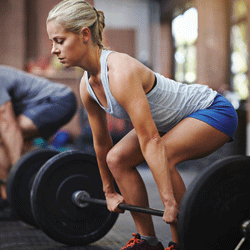So you’re short on time when it comes to getting in the gym? Lets be honest, unless you are an elite athlete, it’s unlikely you have 2-3 hours to spend in the gym. In addition, it has been proven that 45-60 minutes can be optimal for stimulating specific adaptions. However, you want to get the most out of your session. In this article I am going to give a number of examples of training to develop multiple aspects of performance.
Barbell Complexes
All the examples I am going to give are based around the use of barbell complexes. A complex is simply a series of exercises linked together. You may do this for a number of reasons. The most simple reason for performing a complex may be to increase training density within a session. If you only have a certain amount of time to get work done, performing two exercises in series is a much smarter options than splitting them up. However, you can go further than simply picking a couple of exercises and throwing them together.
Examples Of Training To Develop Multiple Aspects Of Performance
Here i am simply going to list off a couple of example complexes, along with the reasoning behind why you may find them beneficial.
- Power clean + front squat 5 x 2+2. So 2 power cleans, followed by two front squats. Aggressive triple extension in the power cleans followed by squat strength in the front front squats. Why separate movements when you can improve two things simultaneously. Not enough stimulus or want to make it bias toward 1 aspect? Simply adjust the volume to front or back load it e.g. Squat volume bias – Power clean + front squat 5 x 2+4, pretty simple?!
- Snatch + overhead squat 7 x 1+3. 1 Snatch develops triple extension, core to extremity transmission of force, coordination and midline stabilisation. The overhead squat then works to overload the midline stabilisation and both squat and shoulder endurance.
- Deadlift + power clean + push jerk 5 x 3+2+1. 3 deadlift, 2 power cleans and 1 push jerk. By adding the “strength” specific exercise at the start, it can act to potentiate the power cleans. The addition of the push jerk requires you to reorganise the body from a “pull” dominant sequence into a “push” dominant movement. So you’re working on strength/hinge endurance, power, triple extension, coordination, upper body push strength, core to extremity, stabilisation and fatigue management? Sounds a pretty sweet deal to me!
Problems, Critics & Coaching
As with anything, there are pros and cons. I feel that barbell complexes such as the following can have great benefit. Non strength sport athletes can benefit hugely as total weight lifted is not the be all and end all! However, as I mentioned earlier make sure there is a purpose to the complex and you know what you looking to work on. Remember you are training to develop multiple aspects, so know what they are!
You may argue that linking the movements may not provide the maximal stimulus possible and I would say you’re right. It’s a game of balance! Yes, you may be able to elicit a greater response if you target just a single aspect. Yet this may mean you sacrifice another aspect as you do not have the time or energy available to train multiple movements separately.
I regularly use complexes, not only barbell, when training clients in Richmond and Twickenham. As a leading personal trainer in south west London, it is essential to keep sessions varied and interesting. If I can provide fun and challenging complexes that keep clients involved, while ensuring they are in line with their goal I’m onto a winner.
